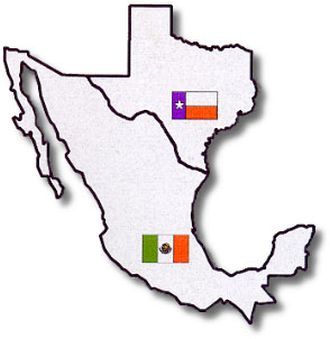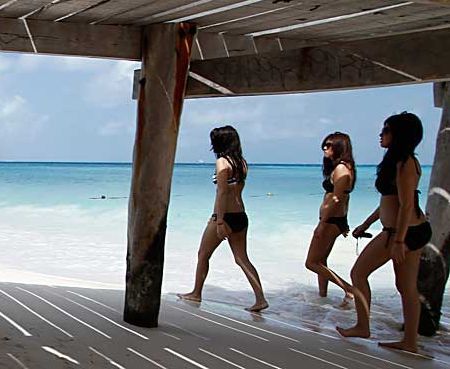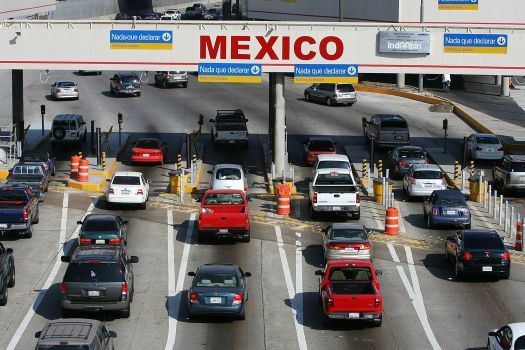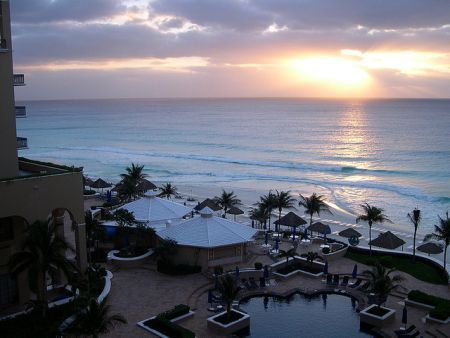
Publisher:
Bonnie King
CONTACT:
Newsroom@Salem-news.com
Advertising:
Adsales@Salem-news.com

~Truth~
~Justice~
~Peace~
TJP
Mar-10-2012 19:45

 TweetFollow @OregonNews
TweetFollow @OregonNews
Texas and Mexico Spar over Spring Break
Salem-News.com“The situation in Mexico today is significantly different than it was just a decade ago,” - TDPS Director Steven C. McCraw
 A Texas travel warning is causing serious friction between the U.S. state and Mexico. |
(LAS CRUCES, NM) - The latest Mexico travel warning emitted by the state government of Texas has set off a wave of criticism south of the border. Government officials and representatives of the international tourism industry lashed out against a March 6 advisory issued by the Texas Department of Public Safety (TDPS) that urged young springbreakers not to visit Mexico this vacation season because of ongoing narco-violence and other criminal activity in the neighboring country.
Citing information from the U.S. Department of State, the TDPS warning highlighted an increase in the number of U.S. citizens murdered in Mexico, from 35 in 2007 to 120 in 2011, as well as other violent crimes including kidnapping, carjacking, highway robbery and more.
“Rape and sexual assault continue to be serious problems in resort areas,” the TDPS stated. “Some bars and nightclubs, especially in resort cities such as Cancun, Acapulco, Mazatlan, Cabo San Lucas and Tijuana can be havens for drug dealers and petty criminals.”
At a tourism industry gathering in Berlin, Mexican Tourism Secretary Gloria Guevara charged that the warning violated World Tourism Organization standards which stipulate travel advisories should convey precise information about danger zones, down to the city block in question.
Further, the Mexican functionary said “the Republic of Texas” was acting outside proper diplomatic channels that were fine-tuned last year after Mexico requested that Washington be more specific when issuing travel advisories to springbreakers and other tourists.
Coinciding with the Super Tuesday primaries in the United States, the warning “seems to have a political agenda,” Guevara added.
 |
 |
Texas’ message to springbreakers also paralleled Vice-President Joe Biden’s trip to Mexico, where he met with Calderon administration officials and the three top presidential contenders in this year’s election.
Jorge Lara, commissioner of political development for the Interior Ministry, characterized the warning as a unilateral exercise that was disruptive of bilateral U.S-Mexico relations.
Arturo Sarakhun, Mexico’s ambassador to the U.S., also said the DPS warning could have a political taint.
“As its number one trading partner and biggest export market, Mexico believes Texas must evaluate the facts more objectively, provide nuances and context, and while doing this get rid of the notion that its agenda is clearly political,” Sarakhun said.
Contending that the advisory “distorts reality,” the diplomat pledged that the security of tourists was guaranteed. Sarakhun pointed to a special Federal Police operation underway in Acapulco’s main tourist zone as an example of the importance authorities put on visitor safety. The police deployment was praised by Javier Saldivar Rodriguez, president of Acapulco’s Chamber of Commerce.
However, in its message to spring revelers, the State of Texas insisted that conditions had changed for the worse for visitors in Mexico.
 |
“The situation in Mexico today is significantly different than it was just a decade ago,” TDPS Director Steven C. McCraw said in a statement.
 Courtesy: KPBS.com |
“Many crimes against Americans in Mexico go unpunished, and we have a responsibility to inform the public about safety and travel risks and threats,” McCraw said. “Based on the unpredictable nature of cartel violence and other criminal elements, we are urging individuals to avoid travel to Mexico at this time.”
An undetermined number of Texas residents are likely to ignore McCraw’s words. University of Texas at El Paso student Javier Pacheco said he intended to fly to Mexico City with his 16-year-old sister in order to attend a family gathering. Quoted in El Diario de El Paso, another El Pasoan, Rogelio Hernandez said a planned visit Mazatlan would provide an optimum beach experience since there would now be “less springbreakers.”
Sonora state tourism head Javier Tapia discounted negative impacts from travel warnings. Tapia said thousands of U.S. springbreakers were expected in Puerto Penasco during the coming days, adding that neighboring governor of Arizona Jan Brewer had declared Sonora the safest Mexican border state. Puerto Penasco is sometimes referred to as “Arizona’s beach.”
In Mexico, the TDPS statement stirred strong criticisms in tourism-dependent communities that are struggling hard to recuperate from a long crisis tied to the global economic melt-down, insecurity and other factors. The critics charge that sweeping travel warnings unfairly hurt secure destinations and produce economic devastation.
 |

Although the Secretariat of Tourism (Sectur) reported a slight recuperation in international tourism during 2011, the number of U.S. visitors dropped three percent in comparison to 2010, which was a very bad year. To some extent, Mexico compensated for the loss by continuing to attract a healthy stream of Canadian visitors in addition to newcomers from countries like Brazil and Argentina.
Tourism flows, however, are uneven and benefit some destinations more than others.
Acapulco, Guerrero, for instance, registered a 52 percent drop in international air travelers during the third trimester of 2011; the number of cruise ships docking in the Pacific port is expected to drop from 80 in 2011 to only 14 in 2012. Sectur official Fernando Olivera said the hotel occupancy in the city averaged only 37.7 percent last year, though the figure represented an improvement from 2009’s average occupancy of about 34.8 percent.
Fernando Hinterholzer Diestel, Guerrero state delegate for the federal Secretariat of Labor, blamed insecurity for the recent closures of 1,200 businesses in Acapulco and three other Guerrero cities.
“The businesses closed mainly because they were not profitable, due to the sensitive drop in tourism that the tourist destinations of Guerrero experienced,” Hinterholzer said. Nowadays, many Acapulco businesses are in bankruptcy and unable to pay taxes and employee salaries and bonuses, businessman Javier Saldivar said.
 Alberto Fernandez |
Overall, international tourism has decreased 20 percent in the resort of Ixtapa-Zihuatanejo up the coast from Acapulco, according to Alberto Fernandez, Zihuatanejo’s municipal director of tourism.
Across from Texas, the border city of Ciudad Juarez has been bludgeoned by the tourism downturn. According to Sectur, the city’s hotel occupancy rate plunged by 38.7 percent from 2007 to 2010. And the decline would have been far worse had it not been for the thousands of federal and municipal police lodged in the city’s hotels at tax-payer expense.
Although Mexican officials hold that the violence which drove visitors away is waning, killings and other crimes keep making the headlines. In a 12-hour period March 6-7, nine people were reported murdered in Ciudad Juarez. On Friday, March 9, police recovered the head of a man packed in an ice chest left below a monument. A narco-style message was left with the head but authorities did not publicly disclose its contents.
Considered Mexico’s second-most violent city after Ciudad Juarez in 2011, Acapulco has experienced shoot-outs, kidnappings and homicides, including multiple incidents in tourist zones. Municipal police have long been implicated in criminal acts and abuses of tourists. Last week, the Federal Police were assigned the exclusive duty of patrolling the Costera tourist strip during evening hours.
In recent weeks, the Federal Police has announced repeated blows against one criminal organization in particular, La Barredora, rounding up at least 16 alleged leaders and other key members. Still, with another half-dozen or so underworld organizations operating in Acapulco and nearby areas, frequent murders stain the city.
Acapulco Mayor Manuel Anorve claimed last week that violence was on the decline and tourism on the upswing. Anorve said hotel occupancy reached 73 percent the first weekend of March, as restaurants and nightclubs filled their tables and dance floors.
Challenging the Texan perception of the reality on the ground, Anorve said the old crown jewel of Mexican tourism was attracting “Canadians, Americans, Russians, Japanese…and a good number of Colombians.”
In the big picture, Mexican tourism promoters are increasingly concerned about the effects of travel advisories and negative news at a time when competition is growing from Cuba, Costa Rica and the Dominican Republic. “It’s easier to create a new tourist destination than to bring one back up that’s fallen like ours,” said Pedro Haces, director of the Tourism Promotion Fund in Acapulco.
Texas’ spring break warning touched raw nerves even in places that have weathered the crisis relatively well. Ruben Reachi Lugo, tourism secretary for Baja California Sur, called the warning a “simplistic one” that does not do justice to the tranquility of his state’s premier resort, Los Cabos, which is favored by U.S. citizens who keep coming in spite of Mexico travel advisories. Reachi said Los Cabos greeted one million visitors last year, including 800,000 U.S. tourists. The upscale resort will be the site of the G-20 meeting of world leaders in June, he stressed.
On the other side of the country, the governor of Quintana Roo, home of Cancun and the Riveria Maya, delivered a sharp rebuke to the Texans. Asserting that “no U.S. tourist has been affected in Quintana Roo,” Governor Roberto Borge Angulo reiterated his stance that travel advisories damage the Mexican tourism industry. According to Borge, the U.S. has even more dangerous cities. The Mexican leader vowed he would travel to Austin, Houston, Dallas and San Antonio to counter the TDPS warning.
The Texas-Mexico spring break flap followed a similar one that broke out last month after the U.S. Department of State issued a travel warning that advised against non-essential travel to all or part of 14 Mexican states. Unlike the Texas warning, Washington’s statement did not recommend against visiting Mexico at all, and even stated that no advisories were in effect for Los Cabos or Cancun, both of which were listed as problematic places by the TDPS.
The State Department warning read in part:
“Millions of U.S. citizens safely visit Mexico each year for study, tourism, and business, including more than 150,000 who cross the border every day. The Mexican government makes a considerable effort to protect U.S. citizens and other visitors to major tourist destinations, and there is no evidence that Transnational Criminal Organizations (TCOs) have targeted U.S. visitors and residents based on their nationality. Resort areas and tourist destinations in Mexico generally do not see the levels of drug-related violence and crime reported in the border region and in areas along major trafficking routes.”
 |
Yet the statement contained a qualification:
“Crime and violence are serious problems throughout the country and can occur anywhere. U.S. citizens have fallen victim to TCO activity, including homicide, gun battles kidnapping, carjacking and highway robbery.”
Nonetheless, the State Department warning was misinterpreted by some Mexican media outlets and tourism industry representatives as a blanket recommendation to not visit their country. Regardless of the fine details in print, Mexicans did not welcome the warning. Pascual Romero Garcia, president of the Acapulco branch of the Canacintra business association, suggested that Mexican authorities should file complaints with the “international human rights commission” and Amnesty International.
Skewering Washington’s travel warning, Guerrero columnist Ruth Tamayo Hernandez took the U.S. to task for issuing statements that reeked of hypocrisy. According to Tamayo, the Mexican bloodbath has been stoked by U.S. arms exports and episodes like the ATF’s much-criticized operation in which “(Washington) looked the other way as arms of all kinds, including those of the Rambo type, were introduced into our country.”
Sources:
- El Diario de El Paso, March 9, 2012.
- El Paso Times, March 9, 2012. Article by Marisela Ortega Lozano.
- La Jornada, March 8, 2012. Articles by Javier Chavez and Alfredo Mendez.
- Milenio.com, March 8, 2012. Article by Felipe Larios Gaxiola.
- Frontera/SUN, March 7, 2012. El Sur/Agencia Reforma, March 7, 2012.
- El Diario de Juarez/Agencia Reforma, March 7, 2012.
- Despertar de la Costa, February 10, 2012. Articles by Eliuth Rios Espinoza and Ruth Tamayo Hernandez.
- El Sur, February 8, 9, 10, 11, 13, 14, 2012; March 10, 2012. Articles by Salvador Serna, Daniel Velazquez and Karla Galarce Sosa.
- Tribuna de la Bahia/Agencia Reforma, January 13, 2012.
- El Diario de Juarez, December 23, 2010 and March 9, 2012.
Frontera NorteSur: on-line, U.S.-Mexico border news
Center for Latin American and Border Studies
New Mexico State University
Las Cruces, New Mexico
 |
Articles for March 9, 2012 | Articles for March 10, 2012 | Articles for March 11, 2012

googlec507860f6901db00.html
Salem-News.com:



Terms of Service | Privacy Policy
All comments and messages are approved by people and self promotional links or unacceptable comments are denied.
john April 24, 2012 9:02 am (Pacific time)
When you have that many crooked police, thats enough reason right there to stay away from that country. Pay your police more Mexico and we will come down there again. Sure our crime rates maybe the same but your policia sucks!!!!!
Anonymous March 11, 2012 6:27 pm (Pacific time)
gm9595 there are a lot of dead, injured and robbed Americans who wish they did not go for that cheap beer. Mexico still has their oil, but their tourist industry will continue to spiral down. The place will become a cross between Bolivia and Columbia. They will continue to cross into our country, will not assimilate, and in time we will be in for some very violent times, hell just look at their violent crime rates now. When whites start getting killed disproportionately higher than they already are (look at the FBI stats), then they will be dealt with in a final way. It will be like a creeping Somalia, starting in LA and other failed communities in California. I feel sorry for my people who live there. Even now many are walking away from their homes, even when paid for. They see it coming like a speeding locomotive. Like a deadly black brownish fungus.
gm9595 March 11, 2012 7:21 am (Pacific time)
How could anyone leave the brown,oil stained and murky brown gulf waters to go to the white prisitne beaches and crystal clear waters of Mexico where the food and beer is half the price of Texas or Florida.
Anonymous March 11, 2012 5:48 am (Pacific time)
I have an idea. Stay in Salem - it sounds and looks like Mexico
BeSafe March 11, 2012 4:38 am (Pacific time)
I think our Federal government should follow Texas with the warning to "avoid" travel to Mexico altogether. Way too many people are dying in Mexico. Many are tourists and many of the deaths are happening inside to the resorts. Read their stories on: www.mexicovacationawareness.com
[Return to Top]©2025 Salem-News.com. All opinions expressed in this article are those of the author and do not necessarily reflect those of Salem-News.com.